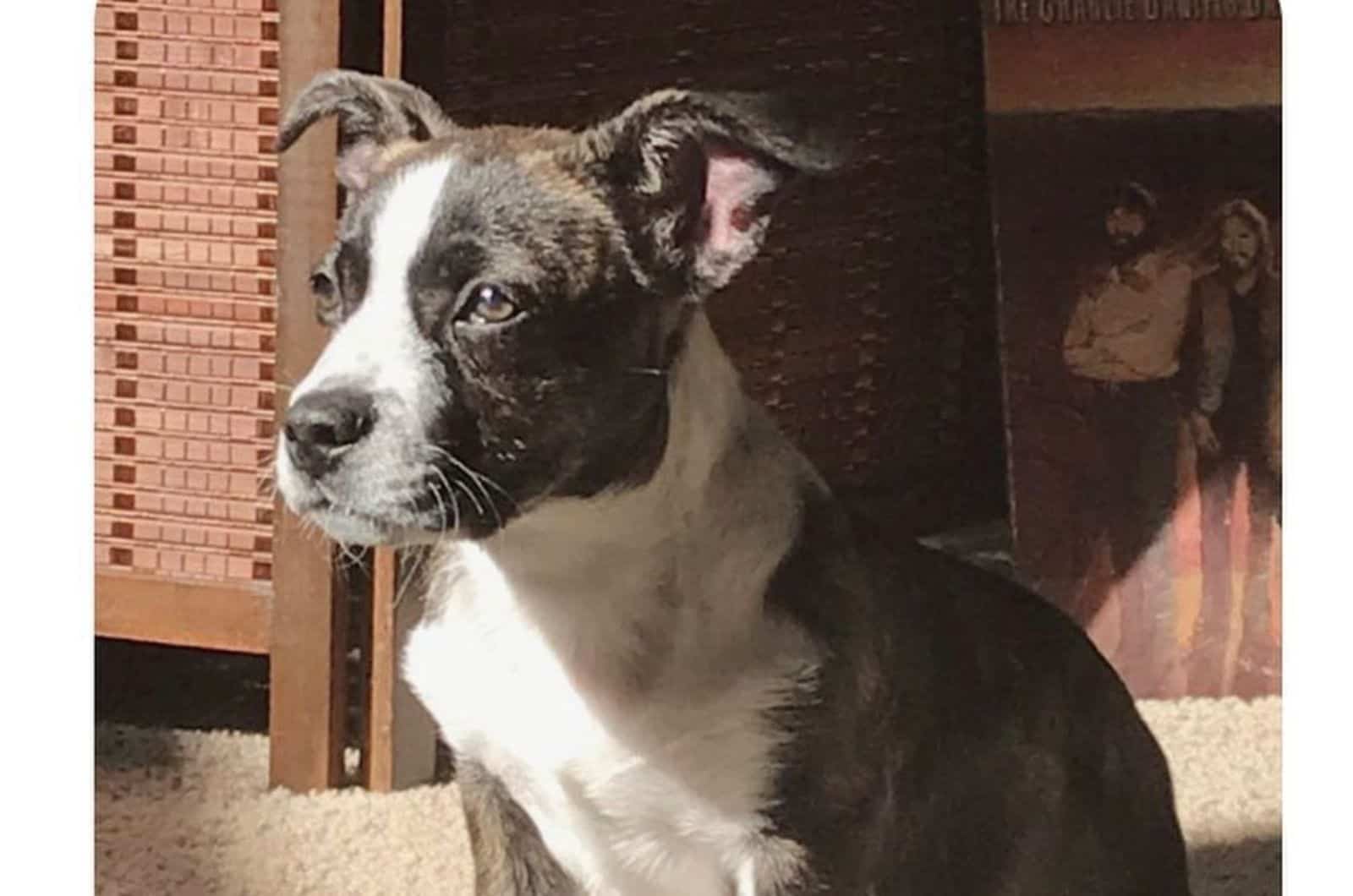Europe is a place where some of the most popular and beautiful dog breeds come from, but what happens when you combine England and France’s favorite dog breeds and get the Corgi French Bulldog mix?
Well, the Corgi French Bulldog Mix is a pretty adorable mixed breed between two obvious candidates, the Cardigan Welsh Corgi and the French Bulldog, also known as the French Corgi.
They don’t have a distinct look as the genes can vary wildly and the dog can inherit varying traits from both parent breeds.
Some may end up with heads more akin to that of a Corgi, others may end up looking like a Frenchie with the pattern of a Corgi, or a number of other mix options.
But is it an improvement over the two existing breeds and is it worth the effort that’s needed to get this hybrid dog with the ideal traits from both sides?
Well, it depends on who you ask, but there are various pros and cons to owning one of these designer dogs in particular.
We’ll go over the details of the dog’s parent breeds briefly before diving into the crossbreed itself to find out if there’s a difference between them at all and to see if it’s even worth getting one.
So, read on to find the answer to that out as well as the answer to a few other questions people often ask regarding this particular breed.
The Corgi French Bulldog Mix: What Is It?
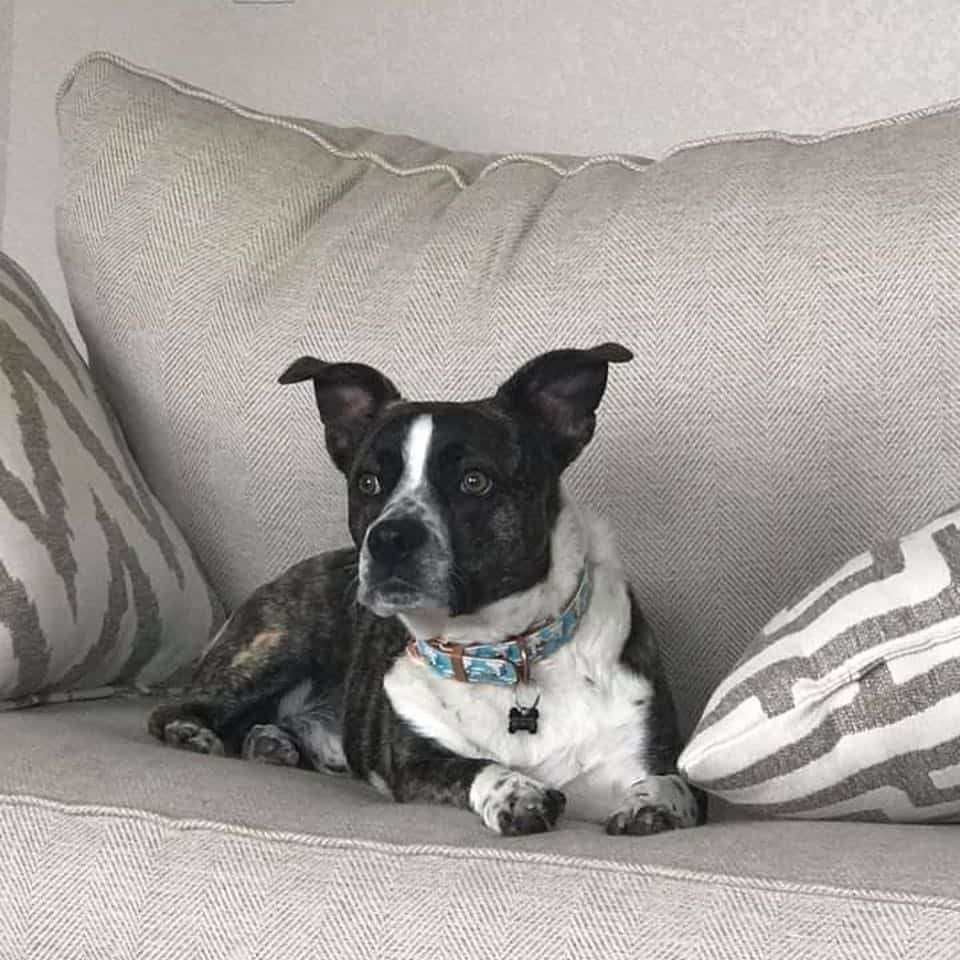
The Corgi French Bulldog mix was a crossbreed made to create an ideal companion dog by mixing the best traits from both the Frenchie and the little gentleman from Wales, the Corgi.
It was also an attempt to eliminate the French Bulldog’s brachycephaly without having to change much else about him as well as eliminate some of the other more common problems between the two breeds.
They also ended up providing the newly made breed with longer legs which helped alleviate some of the strain from walking on the stubby legs the two breeds were known for.
The result was this mixed breed dog who makes for a great watchdog given the history of the Corgi being an excellent herding dog as well as being an incredibly good family dog who needs little to no prior socialization to be good with kids and other dogs.
The latter is a trait that comes from both sides, albeit the Frenchie helps tame that prey drive that the Corgi possesses where he’d otherwise be nipping at the kids to get them in line.
The Parent Breeds
To further delve into what makes this breed an improvement over its parents, we need to understand the parent breeds themselves as well as their benefits and their shortcomings.
Because, even when a dog breed is already great, there’s always room for improvement, as long as said improvement is to the benefit of the dog rather than his detriment.
The Cardigan Welsh Corgi
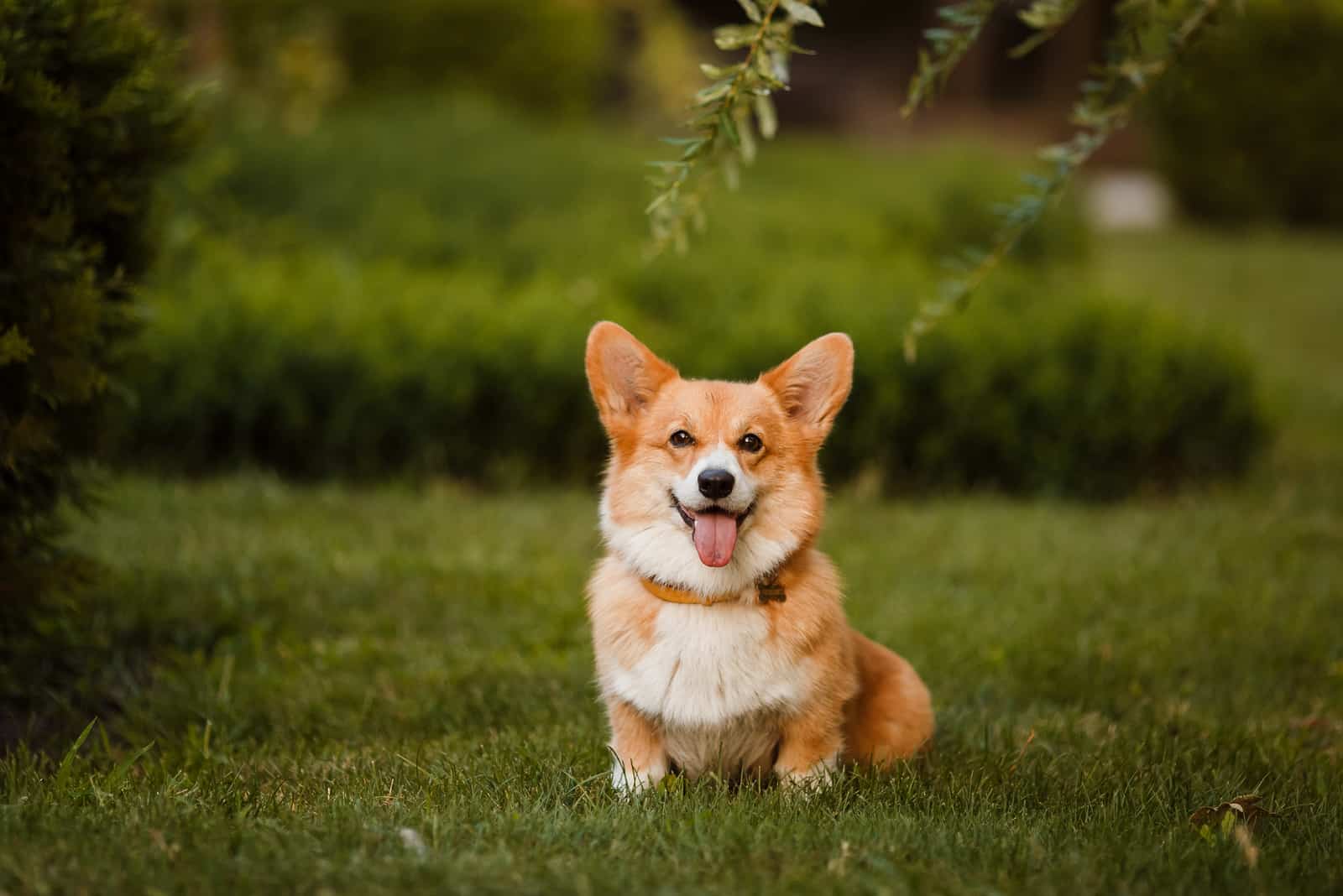
The first parent is the beloved Corgi, one of the most iconic small dogs and the late Queen Elizabeth II’s pet of choice.
Breed History
The Corgi is one of Britain’s oldest and most revered breeds, one of the main reasons being their ties to the royal family, but back in the day, they weren’t exactly exclusive to them.
Flemish weavers brought them over to the shores of today’s UK to Pembrokeshire county somewhere in the 12th century.
They were initially used as herding dogs who’d keep livestock in check with their incredible intelligence and efficiency, as well as their nimble stature that allowed them to weave between large herds.
Despite being small, they had an air of authority with the animals and were rather successful, their tails often docked to make them more efficient and to prevent any workplace injury.
Aside from their job as herding dogs, they also helped hunt down vermin around homes to protect the feed for the livestock in question.
Most assume that both the Cardigan and Pembroke Welsh Corgi originated from northern Spitz dogs back in the day, while some others believe the Teckel is the actual point of origin.
There wasn’t even any distinction between the two until somewhere around the 1930s where they were separated into what we know them as today.
As for when they arrived on our shores, that happened around the year 1934, and, in that very same year, they were recognized as a breed by the AKC (American Kennel Club), allowing them to participate in AKC certified conformation shows.
Appearance
As far as appearances go, the Pembroke Welsh Corgi is definitely one of the more adorable breeds.
Unlike a lot of the popular herding dogs who tend to be large and bulky, the Corgi is small and nimble.
His double coat has a nice and pleasant texture to the touch and is often seen as a piebald with a white coat and orange markings along his ears, eyes and around his back.
There are different colors, sure, but more on that later.
Another distinction that’s easy to notice at first are his triangular, erect ears which allow him excellent hearing.
They’re firm and slightly rounded so they’re not full points, only adding to his charm.
The Pembroke Welsh Corgi in particular has short legs, shorter than the Cardigan Welsh Corgi counterpart in case you’re wondering what the difference was.
Finally, they tend to have a stubby tail. While there are some Corgis who are born with a full tail, centuries of tail docking have left their mark on the breed, having it adjust to this particular change.
That said, the act of tail docking for Corgis in particular has been outlawed in the UK given that there’s little to no purpose for said act nowadays given how most Corgis are now used as family dogs and show dogs rather than their initial role as herder.
This means there’s no more risk of the tail getting injured.
Read More: Why Do Corgi Butts Float? 4 Possible Theories
Some Corgis have longer length coats too, but they’re a rarity and a genetic anomaly in general which is more prone to a number of health issues and should thus be avoided if possible.
Temperament
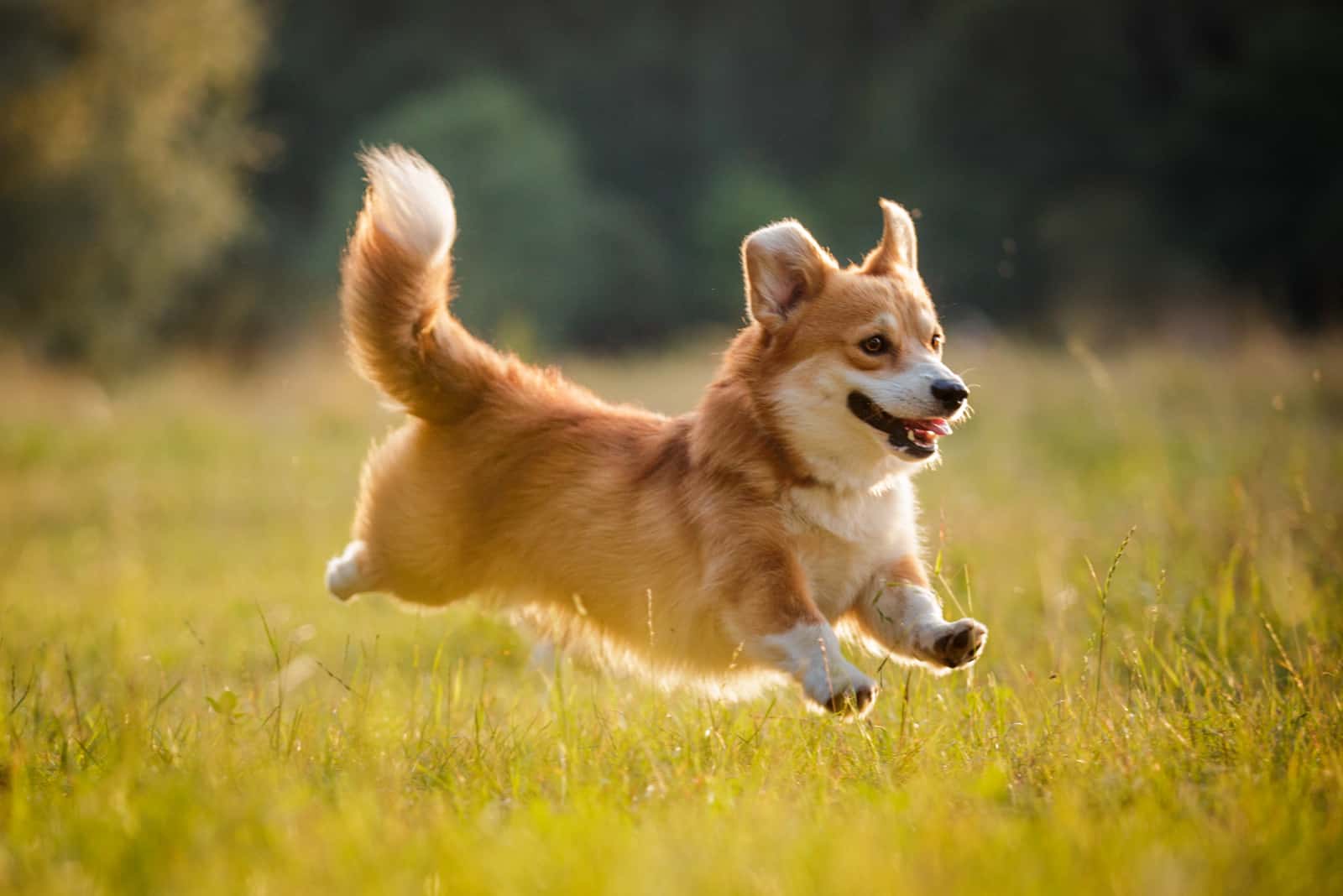
Corgis aren’t the hardest puppers to handle, they’re on the more agreeable scale in terms of friendliness.
Their high levels of loyalty are enviable, but they can be hard to train at times given their breed history.
As one of the more intelligent dogs, the Pembroke Welsh Corgi is prone to being a bit more playful with his owner, which is where said stubbornness stems from, but it shouldn’t cause you any long term issues.
While small, they’re still recommended to use as either watchdogs or herding dogs given their high stamina as well as great eyesight and hearing.
They’re definitely one of the more well adapted hunting dogs which makes them such excellent family pets, but that comes with the drawback of having a relatively high prey drive which has them nipping at small children to get them in line.
A problem that many hunting dogs have, one that’s easily fixed through early socialization with kids and other dogs as part of their behavioral training.
Coat Colors
Depending on which Corgi you’re looking at, there are a few different coat color options, at least ones that are considered to be breed standard, though we are dealing with a hybrid dog here so that doesn’t really play too big a part.
Nevertheless, if you’re going for a Pembroke Welsh Corgi, then you’ll have 4 different coat color options between:
- Fawn
- Sable
- Black and tan
- Red
And, as far as the Cardigan Welsh Corgi is concerned, they have 5 different color options, with those being:
- Red and white
- Brindle and white
- Black and white
- Sable and white
- Blue merle and white
If you’re going for the non standard options, you also have things like:
- White merle
- Gray and white
- Sable merle and white
- Red merle and white
- Liver and white
- Brindle merle and white
Lifespan
The Corgi’s average lifespan is somewhere between 11 to 13 years of age, though through healthy dieting, healthy amounts of exercise and some good luck with genes, they’re known to reach all the way up to 15.
The French Bulldog
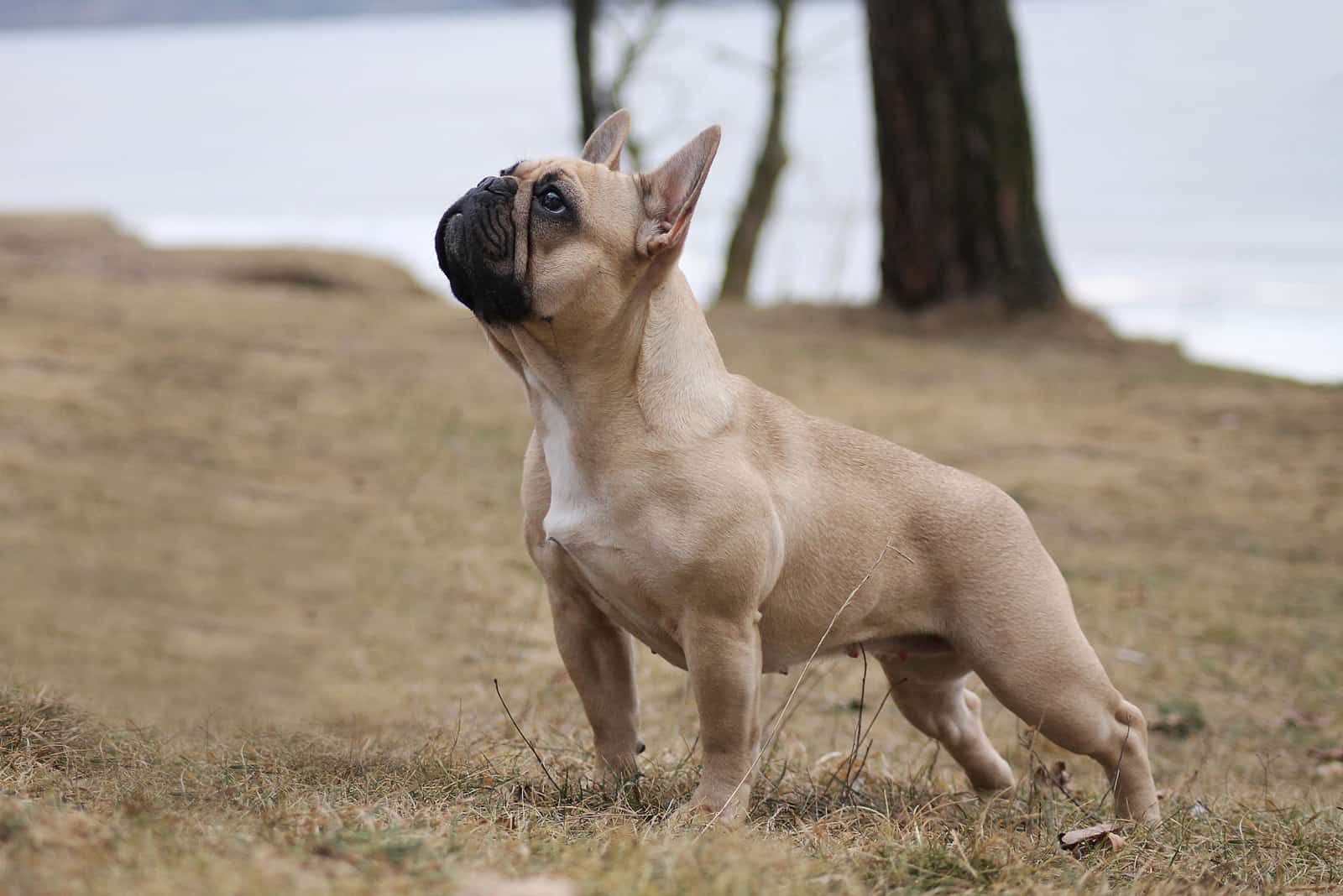
The other parent breed is yet another small breed dog, one of the world’s most favorite dog breeds, even getting second place in global breed popularity. But what does this breed have to bring to the table?
Breed History
Before we delve in any further, it’s important to get acquainted with the Frenchie’s brief, but rich history of how the breed came to be.
The first record of Bulldogs in general comes from the start of the 19th century where they were bred for bull baiting, one of a handful of blood sports popular at the time, thankfully largely prohibited in today’s time.
This is where the name Bulldog comes from, however, French Bulldogs weren’t used for that, they were bred to be pets more so than dogs used for these violent sports.
And, contrary to the name, the first ones were actually bred in Britain, though were called Toy Bulldogs at the time.
It wasn’t until the middle of the 19th century when many of the English workers moved out to Normandy, France to try and find a better life, that the breed appeared, when mixing English Bulldogs (Pugs) and Parisian Ratters.
They brought many dog breeds along with them, one of them being the Toy Bulldogs in question.
The dogs have since gained popularity and, by the middle of the 19th century, somewhere in the late 1850s, the majority of their owners and audience were in France.
Over the course of time, it would be considered its own special breed and highly regarded as a fashion accessory of some sort, a must have ‘item’.
The next decade or so was a blur of missing records, but we do know that the breed was introduced to the United States around the year 1885 in its present state, evolving here and there as the breed got further modernized.
And then, in the year 1898, the breed was officially recognized by the American Kennel Club and logged as it was today, with set breed standards, though experiments still continued to this day in trying to find new coat colors and improving on the breed as a whole.
Appearance
This diminutive little fellow is known to all as you’ve likely seen at least one in your life.
However, this is what a standard Frenchie is meant to look like:
He should have a nice and toned body covered with a wrinkled coat that’s both soft and loose, but silken in texture and smooth to the touch.
He ought to have a square head with a flattened nose and dark eyes, together with soft, but pointed ears.
And the dog is normally meant to be around 12-13 inches tall and weigh up to 28 pounds.
Temperament
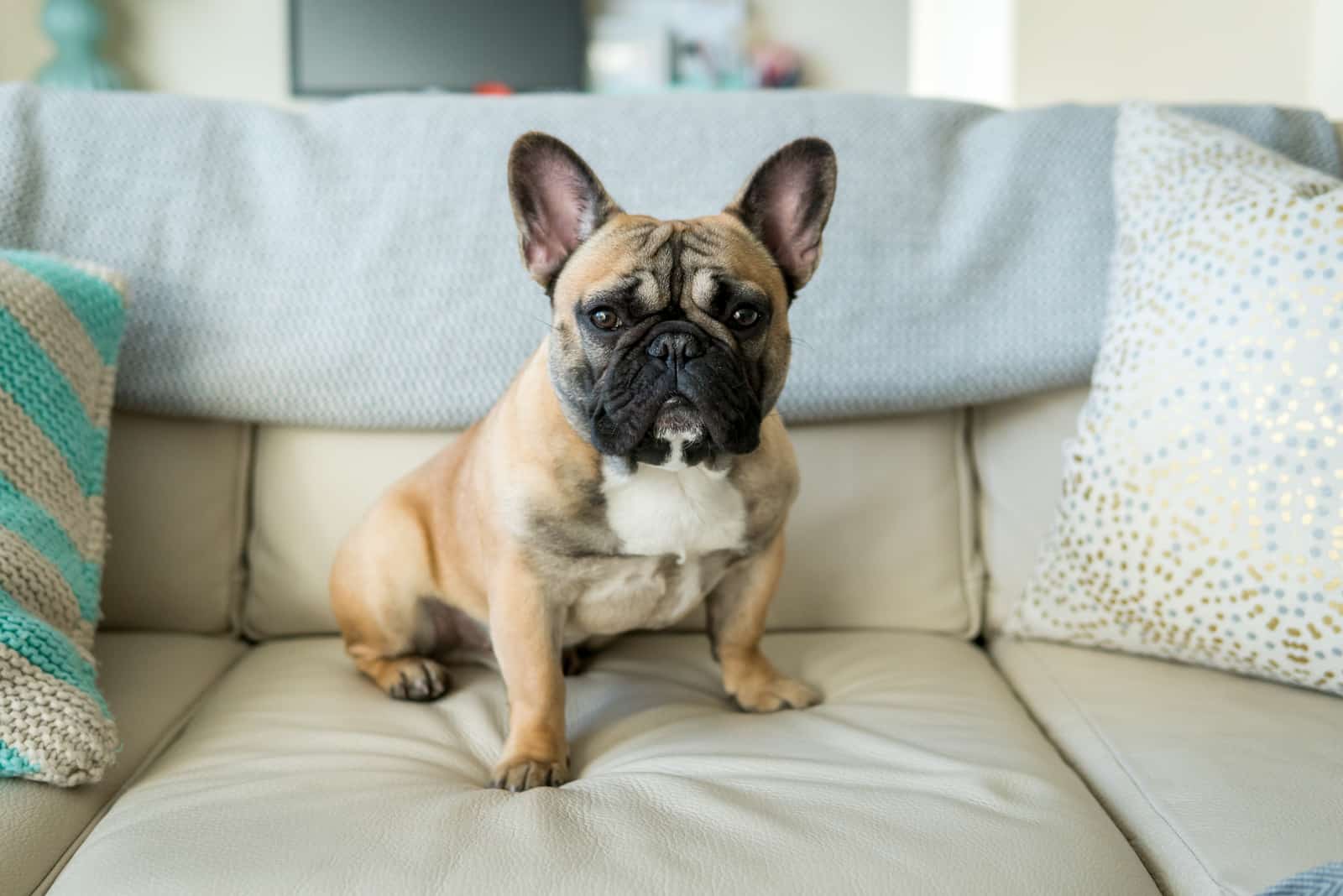
Frenchies are definitely some of the more agreeable dogs. They were raised to be a companion dog breed after all.
They’re not overly combative when it comes to hanging out with other dogs and are great around kids.
They’re quite playful and are always eager to show their love and affection for any new friends that may come their way.
This friendly nature also makes them real easy to train too in all aspects as they’re quite agreeable.
However, they’re not without their faults either as this overly friendly nature leaves them prone to severe bouts of separation anxiety if they don’t get enough human contact which is why they aren’t recommended for people who can’t devote enough time to them.
Coat Colors
The French Bulldog doesn’t separate itself into two different sub-breeds like the corgi does, so it only has one set of colors to work with, but they’re pretty great options regardless.
The standard color options are as follows:
- Fawn
- Fawn & White
- Fawn Brindle & White
- Brindle
- Brindle & White
- Cream
- White
- White & Brindle
- White & Fawn
Though, if you wanted to delve into some of the colors that aren’t approved by the American Kennel Club, then you have a wider variety of choice with these:
- Blue Sable
- Blue Pied
- Blue Brindle
- Blue Fawn
- Red Fawn
Do keep in mind that some non standard colors have been tied to specific health issues regarding the French Bulldog.
Blue, for example, is tied to a higher likelihood for alopecia, which is why it’s recommended to stick with the standard ones, even in terms of crossbreeding.
Lifespan
The average lifespan of a French Bulldog is somewhere around 10-12 years, give or take a few depending on how healthy his diet is and whether or not any particularly nasty complications arise that would affect his health.
However, through regular exercise and proper dieting, the lifespan can be extended all the way up to 14 years if he’s lucky.
The Corgi French Bulldog Mix

With the two parent breeds out of the way, it’s time to talk about the meat and potatoes of the topic, the crossbreed that is the Corgi French Bulldog mix, also known as the French Corgi.
Breed History
As with many other mixes, figuring out the exact point of origin is quite difficult, though it is assumed that, like with most other mixes that don’t have a set point of appearance, they likely popped up somewhere in the 90s.
That was the prime period where a lot of mixed breed experimentation was going on in order to try and one up the purebred options and curate the “perfect dog”.
In this particular case, it was done in an attempt to cancel out the detrimental sides of both breeds, be it the separation anxiety and breathing problems of the Frenchie, or the high prey drive of the Corgi.
Appearance
Their appearance is more reminiscent of the French Bulldog mixed in with several physical aspects of the Corgi parent.
The head will still be square shaped like that of a Frenchie with soft, and pointed ears, but the snout will not be as flat and would be more akin to that of a Corgi, avoiding the brachycephalic detriment that the French Bulldog possesses.
They’re still small which is a shared trait between the two parent breeds, but they will remain quite well built and muscular underneath their soft and squishy skin and short coat, and will possess a lot of stamina.
The breed normally has a strong neck too, being able to support the head with ease without any slumping whatsoever.
He’ll have small, but longer and more powerful legs than his parents to pair alongside his newfound constitution as well.
The tail is the one thing that’s going to vary the most from one dog to another as it can either be a longer one inherited from the Frenchie or it can end up being bobbed should the Corgi parent’s gene be the more dominant one.
As far as their actual dimensions go, the Corgi Frenchie mix will have a varied height and weight between their male and female counterparts with the male ones reaching around 30-ish pounds weight wise and around 13-14 inches height wise.
The female representatives on the other hand are somewhat smaller in terms of weight, coming in at a mere 20-21 pounds of weight while remaining about the same height wise.
Though they lean more toward being an inch or two shorter than the males of the breed.
Temperament
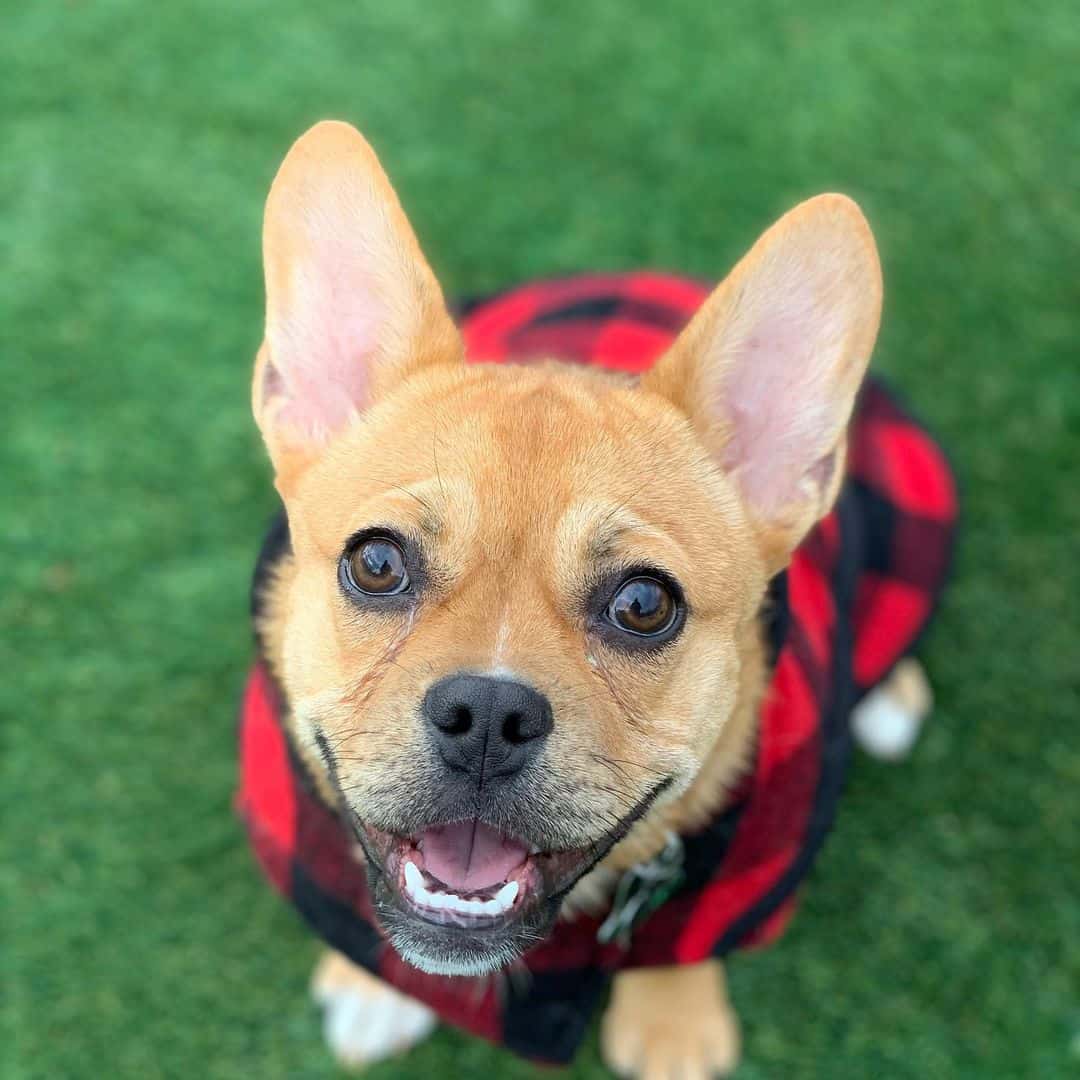
The French Corgi’s temperament is, to no surprise, a healthy mix between the temperaments of his two parent breeds.
They’re still extremely lovable and eager to hang around both humans and other dogs, preferring the former to the latter, but neither tends to be a problem, especially if you do some early socialization as part of his behavioral training.
Though, while some degree of separation anxiety is still likely to be present, it won’t be as prominent as that of the French Bulldog.
Similar to that, they’ll be a lot more energetic than the Frenchie, but it won’t be too much to the point of being a nuisance as they have a more tempered prey drive.
And, they can be both great companion dogs while still performing the duty of a decent watchdog.
Coat Colors
Given that the French Corgi mix is a mixed breed, he can end up having any of the aforementioned coat colors of his parent breeds.
There aren’t any particular standard colors as no mixed breed is recognized by the AKC to help standardize some of them.
However, some of the more common ones that you’ll be seeing would be:
- Fawn
- Red
- Black
- Sable
- Tri-colored
- Any brindle variant
Others may pop up here and there, but, as mentioned before, some non standard French Bulldog colors are often tied to various health problems so breeding with them is often avoided.
Grooming Needs
How challenging it is to groom a Corgi French Bulldog mix is dependent on the owner’s outlook on it, but it’s not as hard as some other breeds tend to be.
The short coat makes brushing and bathing relatively easy and you’ll only need to really do the latter every 6-8 weeks or so, if even that given how clean these dogs tend to be.
That said, they’re certainly not hypoallergenic and are considered to be moderate shedders meaning you’ll have to devote a bit of your time to several brushing sessions throughout the week.
Do be sure to use a slicker brush as any long-haired brush may end up hurting them and won’t really perform any better than the aforementioned slicker brush which will be gentler on their skin.
Nail trimming isn’t that hard either, though you may want to be careful still, just don’t let the nails get too long.
Other than that, their teeth will mostly do some self cleaning if you’re feeding him high quality dry dog food, but giving them a brushing every now and then just to make sure won’t hurt either.
Their ears are the real problem though as those bad boys accumulate wax like it’s nobody’s business and can cause temporary hearing problems if not properly maintained, so be sure to clean them out every now and then.
Food & Nutrition
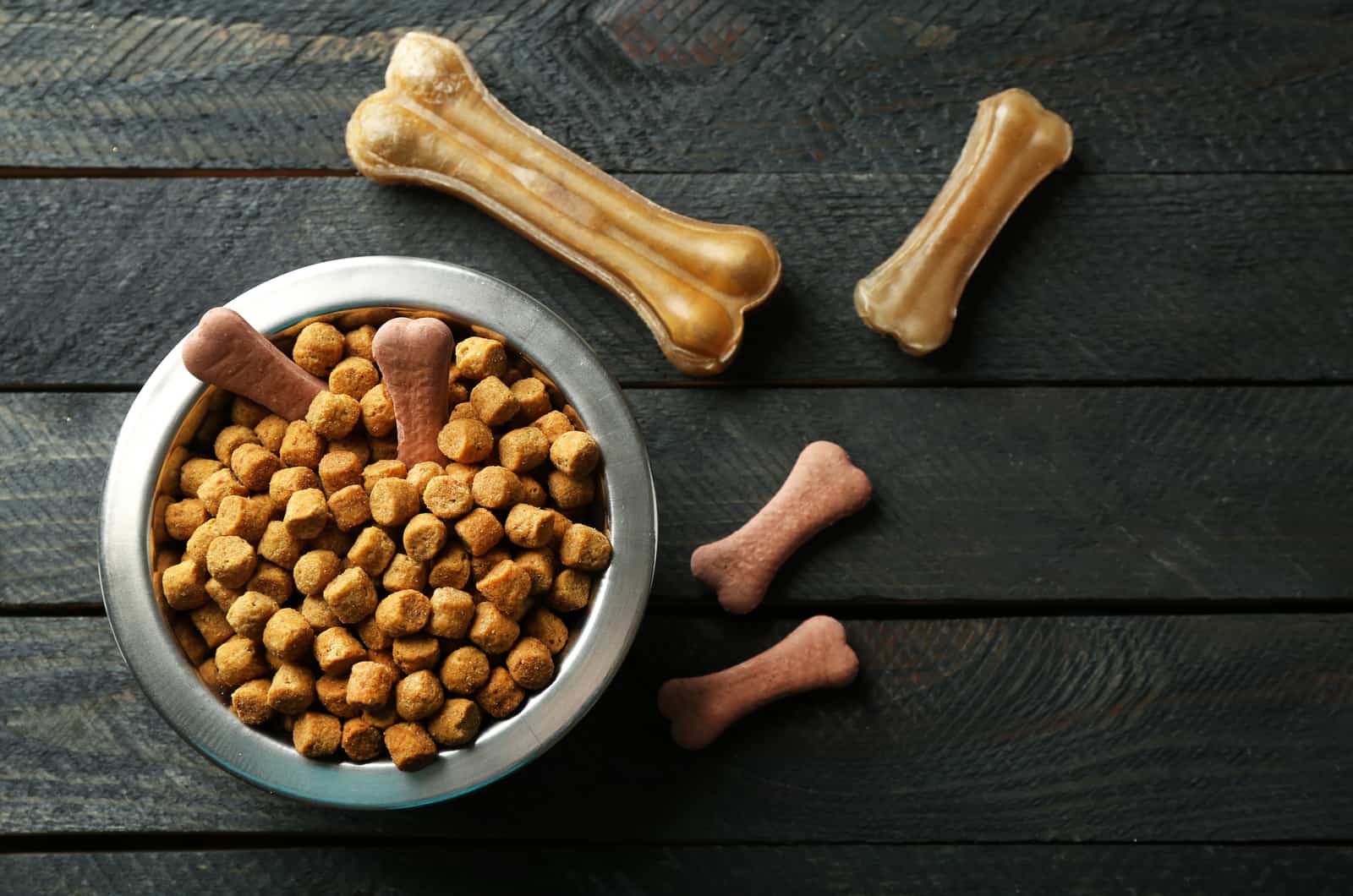
The food for a Corgi French Bulldog mix remains relatively the same as that of his two parent breeds.
If you’re ever confused on how much they need to be fed, then consulting either of their feeding charts is likely to be your best quick reference guide, but consulting with a pet nutritionist or your dog’s vet will yield more precise results.
This is mostly the case due to there not being enough research done on every particular hybrid dog breed.
Though you can also use the feeding charts that are normally printed on the bags of the food itself.
As far as nutrition goes, well that remains standard among all dogs with several key nutrients to be on the lookout for to help your dog better develop during his puppy years and to keep him strong throughout adulthood and onward.
Here are some of the key ingredients:
Quality Protein
Often dubbed as the first ingredient, protein is a key component of every meal and every diet, helping build up muscle mass and providing energy.
The two best protein options for any dog are beef and chicken for both quality and affordability, though alternatives such as lamb, turkey or fish do exist.
Fiber
Something to make all that protein go down smoother is always good to have paired with it, a source of fiber, be it rice, sweet potatoes, peas or similar.
Avoid Fillers
Fillers rarely do anything for your dog aside from acting as empty calories, something short dog breeds definitely don’t need given their higher likelihood for obesity.
Omega 3 Fatty Acids
Other than that, you’ll want to make sure that the food contains omega-3 and 6 fatty acids which help keep your dog’s fur nice and shiny and improve your dog’s overall immune system.
Probiotics
Speaking of which, a healthy batch of probiotics and prebiotic fiber is always welcome as it helps foster the growth of healthy gut bacteria which are responsible for digestion and a more responsive and healthier immune system.
Aside from that, you’ll want a healthy dose of vitamins in there, as per usual, to help with overall growth.
DHA and EPA
DHA and EPA are particularly important in puppies as they help develop and maintain their cognitive skills.
Calcium And Phosphorus
Calcium and phosphorus are important too as they help with proper bone and cartilage growth.
Glucosamine And Chondroitin
Aside from those, you also want to include a healthy dose of chondroitin and glucosamine which help maintain bone and joint health, particularly crucial in any medium or large breed dogs given their back problems later on in life.
While all of these are crucial, some are lower priority than others.
The main ones you should be looking out for are the protein, the fiber, the fatty acids and the probiotics. The rest may come along naturally.
RELATED: French Bulldog Feeding Chart: How To Keep Your Frenchie Fit
Health Issues & Lifespan

The lifespan of this mixed breed leans on the longer side of things, averaging out at 12-13 years for most members, but it can go up to 15 if he’s in good health and gets plenty of exercise.
As for the potential health issues, most are hereditary in nature, so expect to encounter the same problems as his parent breeds might have.
Here are some of the more prominent ones:
Brachycephalic Syndrome
While most French Corgis end up with an elongated muzzle, there are those who may still inherit the French Bulldog’s flat face.
This is the main cause for their brachycephaly, or to put it in simpler terms, it makes it a lot harder for them to breathe due to obstructed airways.
This may mean that your dog may not have the stamina of a standard French Corgi and is likely to be less active, not to mention the constant difficulty breathing which may give birth to other problems.
Elbow And Hip Dysplasia
A condition he inherits from his Corgi parent, albeit every dog is prone to this one as it’s caused by the joints wearing out over time and eventually just popping.
It can be made more likely to happen if your dog is overweight, and the best method of prevention for the problem is to keep him in shape as, once it happens, you can’t exactly revert it back.
Ear Infections
As mentioned during the grooming process, a French Corgi’s ears are prone to getting clogged with earwax and other particles which can accumulate over time and, if left unattended, can end up provoking various ear infections.
This has a higher chance to happen with these dogs in particular due to their narrow ear canals and the best method of prevention is making sure the ears are kept clean.
Progressive Retinal Atrophy
A big one that thankfully doesn’t affect too many members of the canine family, but is more likely to happen in Corgis, and thus, can be inherited by the Corgi French Bulldog mix too.
PRA is a health condition where the dog’s retinal cones and rods slowly degrade over time, leading to worse and worse vision until eventual total vision loss.
There’s no known cure for it at the moment, sadly, but know that dogs affected by it can still live relatively healthy lives and it shouldn’t affect their lifespan at all.
Bloat
While not all too common with this particular breed, bloat is a problem that’s always worth being on the lookout for.
It’s a condition where the stomach twists in on itself when trying to retract after distending out too far, usually from overeating or just generally not pacing oneself when consuming food.
It then leads to the contents of the stomach getting trapped inside and the surrounding organs to have their blood flow cut off which can cause further complications.
If you see any signs of bloat, be it attempts at dry heaving, a look of panic or a distended and hard abdomen, take him to a vet immediately to get the problem reversed before any permanent damage occurs.
Deafness
A condition that’s only really a concern if you’re crossbreeding with a non-standard color Frenchie, especially a white French Bulldog as they’re more likely to develop the progressive loss of hearing.
To minimize the risk of this happening, stick to standard Frenchie colors for your dog’s sake. He shouldn’t be suffering for aesthetic reasons.
Intervertebral Disc Disease
An intervertebral disc disease, also known as IVDD, is a health condition caused by the appearance of a hernia in the space between two spinal discs.
This is likely to cause difficulties in walking and urination, as well as a lot of pain for the dog.
However, it is treatable and can be fully cured with proper methods.
If caught early, then it’s mostly down to a lot of rest without much activity to allow the spinal cord to heal on top of pain medication.
However, if the dog is restless and allows the condition to worsen, then a surgical procedure will be needed to fix the damage done.
This problem comes from the Corgi side as they’re a chondrodystrophic breed (a breed that has abnormal skeletal growth), and if the Corgi parent provides the dominant gene, the French Corgi is more prone to suffer from IVDD
Parasites
Finally, parasites are a universal issue for any dog. Their very name reveals their nature and they’re usually contracted from eating uncooked meat or by eating something off the street that was infected by them.
The parasite will latch onto your dear dog’s digestive tract and will siphon the nutrients from his meals, leaving the host weak and malnourished which will lead to a host of other problems.
The most common culprits are ringworms, tapeworms and hookworms.
If you notice your dog acting lethargic or undergoing sudden weight loss with no reasonable explanation, take either him or a stool sample to the vet to test for parasites and a potential de-worming treatment should that be the case.
Cost

While the parent breeds of this wonderful hybrid dog can range from being relatively affordable to pricey depending on their accolades and their bloodline, the mix itself can end up costing a pretty penny too.
This is true despite being unable to perform at AKC conformation shows.
A purebred Corgi ranges anywhere from $700 upwards to around $2000, while the French Bulldog can go from $1500 to a whopping $3000, give or take a few hundred bucks depending on the breeder.
On the other hand, the French Corgi seems to have inherited his “price gene” from his French Bulldog parent as they can go from $1300 all the way up to $3200 depending on coat color rarity and parentage.
All in all, pretty costly, but you may be lucky enough to find some on the lower end or potentially in shelters or rescues which will save you a lot of money but don’t have the guaranteed pedigree behind them.
And all of this doesn’t even account for the extra money you’ll have to invest in getting all the necessary dog gear, shots, dog beds, crates, toys as well as food.
Having a dog is an expensive undertaking, so be sure you have the funds and the time ready to devote to a new member of your family, regardless of breed.
FAQs
Is It Easy To Train A Corgi French Bulldog Mix Puppy?
Much like his parent breeds, the French Corgi is exceptionally easy to train and the best method for training them is through positive reinforcement.
Try avoiding treats as they’re only going to pose an obesity risk and be sure to include physical exercise in their daily training to help them work the accumulated calories off.
A brisk 30 minutes of relatively medium effort should be fine for standard French Corgis, but ones that inherit the flat face of their Frenchie parents should keep it to light exercise due to breathing issues.
Is The French Bulldog Corgi Mix Puppy The Right One For You?
Well, I’d say that’s up to you.
The price is a bit out there, but you’re likely to find them closer to the lower end so it’s not all that bad, and it’s a way for you to get a French Bulldog adjacent doggy without the brachycephaly meaning he’ll have an easier life.
Not to mention that Corgi aspect which only adds to the cuteness and makes the French Corgi an ideal lap dog who won’t cause you much trouble.
The only real downside aside from price is the number of health issues that the dog can inherit which may be a bit off-putting and a big hassle to have to deal with, financially and mentally.
In Conclusion
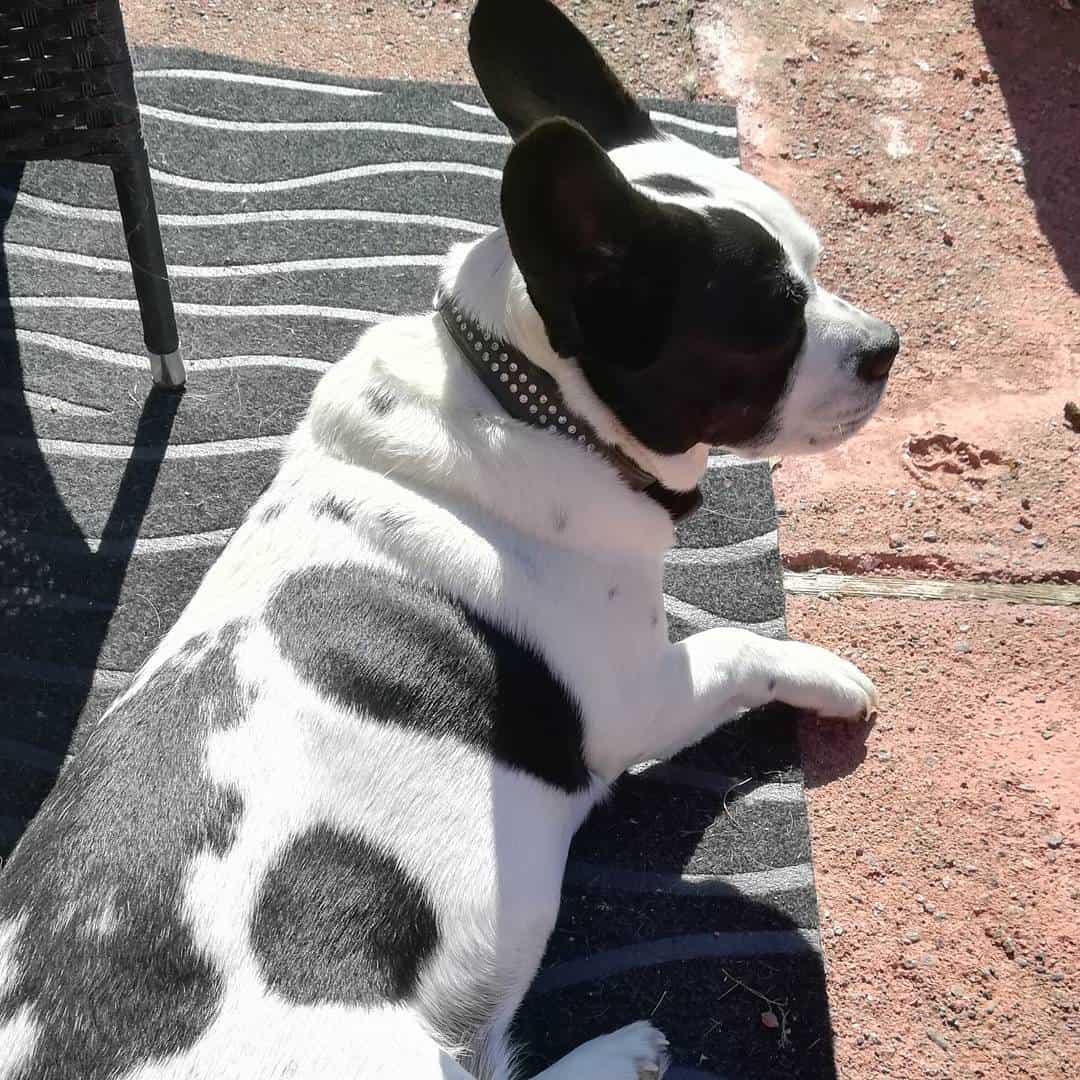
The Corgi French Bulldog mix puppy may not be the most unique designer dog out there, but it’s one that helps iron out the kinks of the two parent breeds allowing owners to not have to worry about breathing problems and making them easier to train.
They may be rare to find, but if you can get one, you’re definitely getting a loyal, friendly and fun-loving doggo, one that makes for an excellent lap and watch dog all in one while not needing too much maintenance aside from the usual stuff.
I’m sure that it’ll be a pooch who’ll end up becoming your furry best friend. Until next time, pet parents.
RELATED LINKS:
- French Bulldog Growth Chart: How Big Can A Frenchie Get?
- French Bulldog Mixes: A Guide To 32 Adorable Crossbreeds
- Fat Corgi Is a Problem — What To Do?
- What Were Corgis Bred For? The Answer Might Surprise You
- Corgi Feeding Chart: The 4.1.1. On Eating Right
- Do Corgis Have Tails At Birth? 3 Reasons For Tail Docking
- Corgi Growth Chart: How Big Do Corgi Puppies Get
- The Top 8 Corgi Breeders In Virginia
